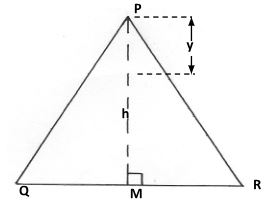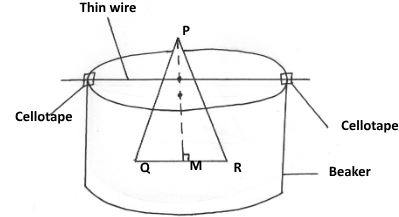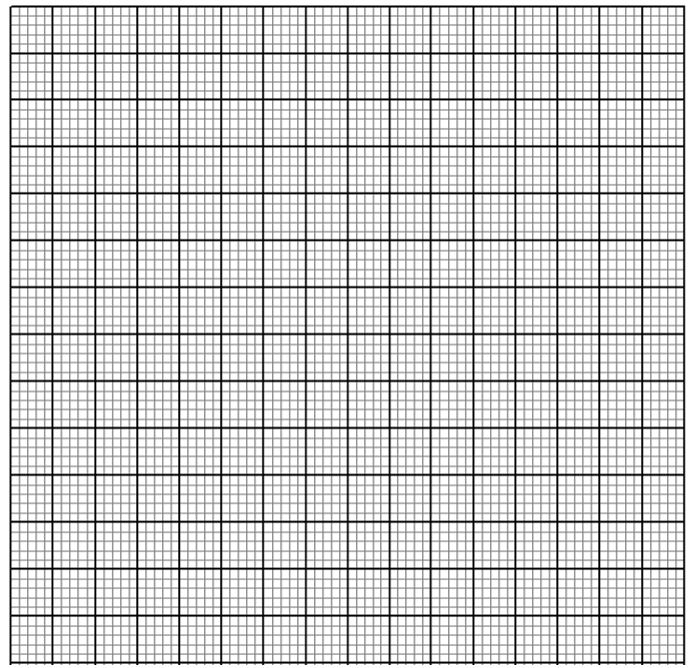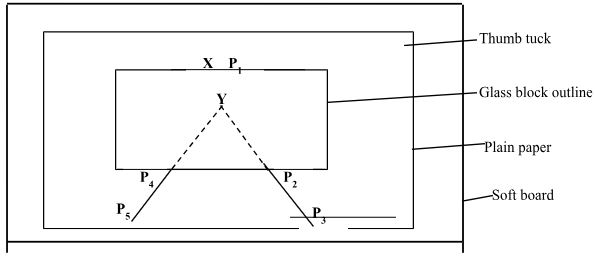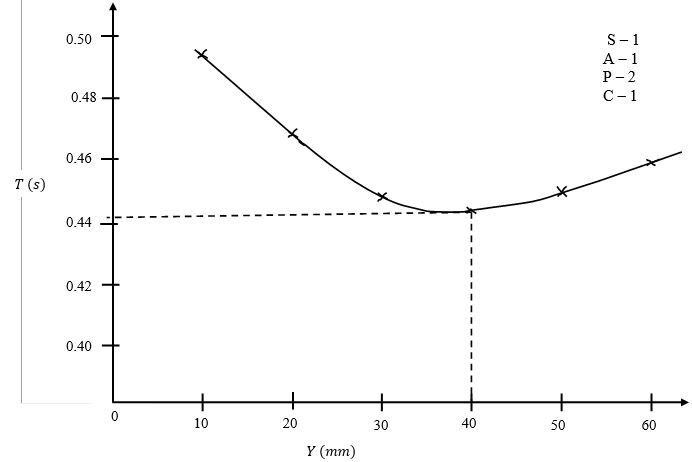INSTRUCTIONS TO CANDIDATES
- Answer all the questions
- You are supposed to spend the first 15 minutes of the 2 ½ hours allowed for this paper reading the whole paper carefully before commencing your work.
- Marks are given for a clear record of the observations made, their suitability, accuracy and use.
- Candidates are advised to record their observations as soon as they are made.
- Non programmable silent electronic calculators and KNEC Mathematical tables maybe used.
QUESTION 1
You are provided with the following:
- Triangular card marked PQR
- Plastic or glass beaker
- Straight piece of wire
- Two strips of cellotape
- Optical pin
- Set square
- Stop watch
You are required to have a complete mathematical set
Proceed as follows:
- Draw the perpendicular line to the base QR and measure and record the height PM, of the triangular card
PM =……………………………….. (1mk) - Using the optical pin provided, make holes along the perpendicular line drawn such that the distance y = 10 mm, 20 mm, 30 mm, 40 mm, 50 mm and 60 mm from P.
- By using a small piece of cellotape, attach both ends of the thin length of wire to the circumference of the beaker with the wire passing through the hole y = 10 mm and the card hangs freely in the figure below.
- Displace the card by the help of a 15 cm rule, so that it oscillates about the wire as an axis. Determine the time for 5 complete oscillations and then find the periodic time T.
Record your values in the table below. - Repeat the procedure in (d) above for other values of y and complete the table appropriately. (7 mks)
Y(mm) 10 20 30 40 50 60 Time for 5 oscillations (s) Periodic time, T (s) - Plot a graph of T (y-axis) against y on the grid provided (5 mks)
- From the graph, determine T, the periodic time for which y = 1/3 (3 mks)
- Hence, calculate the constant from the formula; t = √Q/K where t is the time for 5 complete oscillations when y = 1/3h and Q = 48.4 m (4 mks)
QUESTION 2
PART A
You are provided with the following apparatus:
- A Nichrome wire mounted on a millimeter scale
- 6 connecting wires, 2 with crocodile clips
- An ammeter
- A voltmeter
- A cell holder
- Two dry cells
- A micrometer screw gauge
Proceed as follows:- Connect the circuit as shown below. The length of the wire AB used to complete the circuit should be exactly 1 meter.
-
- Close the switch and record the correct I and the potential difference V across the wire AB. Open the switch.
I = …………… Amperes (1 mk)
V = ……………Volts (1 mk)- Determine the resistance R = V/I, given that (1 mk)
- Close the switch and record the correct I and the potential difference V across the wire AB. Open the switch.
- Measure the diameter, d of the wire AB using a micrometer screw gauge
D……………m (1 mk) - Determine the quality of the material of the wire from the relationship; R = ρl, where A is the cross-sectional area of the wire. (3 mks)
A
PART B (I)
You are provided with the following apparatus:- White screen
- 100 ml glass beaker
- A metre rule
- A candle
- A 100 ml measuring cylinder
- Some water, about 100 ml, in a plastic beaker
Proceed as follows:
- Using the measuring cylinder, measure 80 ml of water and transfer it into the 100 ml glass beaker.
- Place the 100 ml beaker with the water on a metre rule and arrange a lit candle and screen on either side of the beaker as shown in the figure below. Ensure the candle flame is in line with the water level in the beaker.
- Set the position of the candle on the metre rule so that its centre is a distance, u = 12cm from the beaker.
- Adjust the position of the screen until a well focused vertical line (The image of the candle flame) is formed on the screen. Read and record in the table below, the image distance v between the screen and the beaker.
- Repeat the procedure for other values of u shown and complete the table appropriately.
(4 mks)Distance u (cm) 12 16 20 Distance v (cm) Y = uv
u + v - Determine m, the mean value of y using the values in the table above
m = ………………… (1 mk) - With the half-metre rule outside the beaker, measure the height h, of the water meniscus above the bench.
h = …………cm (1 mk) - Determine the value of P given that: P = 5/√h(1 mk)
- Hence determine the value of f, correct to one decimal place, given that:
f = p/2m + 1 (2 mks)
PART B (II)
You are provided with the following apparatus:- A rectangular glass block
- Soft board
- Five optical pins
- Four thumb tucks
- Half-metre rule
Proceed as follows:
- Using the half metre rule, measure the width, w of the glass block
w = ………………cm (1 mk) - Place the glass block on the plain piece of paper and draw its outline.
- Remove the glass block and mark a point X midway along one of the longest sides of the outline. Fix a pin P1 on this point.
- Replace the glass block to fit perfectly on its outline.
- On the opposite side, fix two pins P2 and P3 on the right side of X so that they appear to be in line with the image of P1 viewed through the longer side opposite X.
- Repeat step (e) but with two other pins P4 and P5 on the left side of X as shown in figure
- Remove the glass block and the pins. Draw a line joining P2 and P3 , then another joining P4 and P5. Extend the lines P2P3 and P4 P5 to intersect at y as shown in figure below.
- Measure the distance XY.
XY = ………………cm (1 mk) - Calculate the value given that: (2 mks)
η = w
w − xy
CONFIDENTIAL
The apparatus required by each candidate for the Physics Practical Examination are listed below. It is expected that the ordinary apparatus of a Physics laboratory will be available.
The physics teacher should note that it is his/her responsibility to ensure that each apparatus acquired, for this examination agrees with specifications given.
QUESTION 1
Each candidate will require the following
- An isosceles triangular card, made from manila paper, of base length 6.0 cm and height 12.0 cm. The base is to be marked QR and the apex marked P
- A glass/plastic beaker of volume 500 ml
- A nichrome wire (gauge 22) of length equal to (d + 4) cm, where d is the maximum diameter of the beaker. The wire must be straightened
- Two strips of cellotape or masking tape
- A complete mathematical set
- A stop-watch
- An optical pin
QUESTION 2
- Rectangular glass block, measuring approximately 10 cm by 6 cm by 2 cm.
- Soft board
- Five optical pins
- Four thumb tucks
- Half-metre rule
- White screen
- 100 ml glass beaker
- A metre rule
- A candle
- A 100 ml measuring cylinder
- Some water, about 100 ml, in a plastic beaker
- A nichrome wire (gauge 32) mounted on a millimeter scale.
- 6 connecting wires, 2 with crocodile clips.
- An ammeter (0 – 1 A)
- A voltmeter (0 – 5 V)
- 2 new dry cells.
- A micrometer screw gauge (to be shared)
- A switch.
MARKING SCHEME
Question 1
(a) PM=12.0 ± 0.5 cm 1 dp
(e)
| Y(mm) | 10 | 20 | 30 | 40 | 50 | 60 |
| Time for 5 oscillations ± 0.1 (s) | 2.47 | 2.34 | 2.24 | 2.22 | 2.25 | 2.28 |
| Periodic time, T (s) | Correct division of Student’s values of t by 5 | |||||
Each correct - 1mk
All correct:3dp - 1mk
Y(mm) 10 20 30 40 50 60
(f)
(g) 1/3 h = 1/3 ×12=4 cm = 40 mm
T = 0.444 s
Shown on the graph
(h) t = 0.444 × 5 = 2.22 s (student's value of T × 5)
2.222= √48.4/k) - correct substitution of student^' svalue of t
4.9284 = 48.4/k - attempt to simplify
k = 9.821 m/s2
(9.0 − 10.5) deny for wrong units;no units but within range,1⁄2 mark
Question 2
Part A
(b) (i) I = 0.22 ± 0.02 Amperes
V =1.9 ± 0.2 Volts
(ii) R = 1.9/0.22 = 8.636 Ω
(c) d = 0.00035 m (0.35 ± 0.05 mm)
(d) 8.636 = ρ ×1
π × 0.0001752
ρ = 2.645 × 10−7Ωm (3rd mark for correct unit)
(i)
| Distance u (cm) | 12 | 16 | 20 |
| Distance v (cm) ± cm | 4.9 | 4.1 | 3.9 |
| Y = uv (cm) u + v |
3.479 | 3.264 | 3.264 |
(j) m = 3.479 + 3.264 + 3.264 = 3.336 cm
3
(k) h = 4.8 ± 0.3 cm
(l) P = 5 = 2.282
√4.8
(m) f = 2.282 + 1
2 ×3.336
= 1.342 cm
(n) w = 6.1 ± 0.2 cm
(u) XY = 2.5 ± 0.2 cm
(v) η = 6.1
6.1 − 2.5
=1.694
Download Physics Paper 3 Questions and Answers with Confidential - Samia Joint Mock Examination 2023.
Tap Here to Download for 50/-
Get on WhatsApp for 50/-
Why download?
- ✔ To read offline at any time.
- ✔ To Print at your convenience
- ✔ Share Easily with Friends / Students

